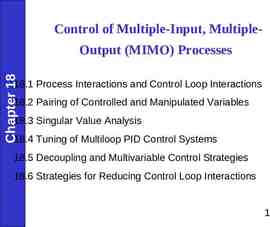Grasshopper Dissection Life Science
14 Slides2.96 MB
Grasshopper Dissection Life Science
Arthropods make up the largest phylum of Arthropods animals in the animal kingdom. Arthropod means “jointed foot”. All arthropods have jointed appendages. Arthropods also have segmented bodies and an external covering called an exoskeleton.
Insects ects are one type of arthropod. Insects have thre dy regions: a head, a thorax, and an abdomen. Antennae Compound Eyes Six Legs nsects also have six legs, one or two pairs of win pair of antennae, and a pair of compound eyes.
Parts Of The Head the diagram below to identify the parts of the he your grasshopper. The grasshopper has 5 eyes, two compound eyes and three simple eyes. The antenna are sensory
Mouth Parts the diagram below to identify the mouth parts o r grasshopper. As you identify each part, try and move it with your tweezers.
labrum is used to hold food. The mandibles are t d to chew food. The maxilla are used to chew and e food. The labium is used to hold food while it is g chewed. Now use the diagram below to locate rnal structures on your grasshopper.
asshopper’s eardrum, or tympanum, is located be second pair of wings on each side of the thorax. te the tympanum on your grasshopper using the ure below. The tympanum is used for hearing. tympanum all insects, grasshoppers have six legs. The front used for walking, climbing, and holding food. The dle legs are also used for walking and climbing. T legs are used for jumping.
sshoppers breath through tiny holes in their abdom ed spiracles. Try and find these tiny holes along e of the abdomen. close up of one spiracle
male grasshopper has a longer abdomen than a m ends with a four pointed tip called an ovipositor. ovipositor is used to lay eggs. Look and the end r grasshopper’s abdomen and determine if it is a e or a female.
snip the endInternal off the abdomen and insert the Structure tip of your scissors under the top surface of the abdomen. Cut straight up the middle of the abdomen all the way to the head. Only cut as deep as the start cutting here stop cutting here exoskeleton or you will cut through the organs. Next, cut the same way up the bottom surface of the abdomen to the mouth. Remove half of
(ovary) heart brain anus esophagus The esophagus is used to swallow food. The rectum crop, gizzard, gizzard gastric ceca, stomach, large intestine, and small intestine are digestive organs. The rectum stores waste and the anus removes wastes from the body. The malpighan tubules collect waste from the blood. In the
w the grasshopper away, wipe your dissecting too wipe your tray out, and wash your hands with soa water. Answer the following questions on a sheet aper. Questions & Conclusions hat is the largest phylum in the animal kingdom? hat does “arthropod” mean? st three characteristics that all arthropods have. hat three body regions do all insects have? ame four other characteristics that all insects hav ow may eyes does a grasshopper have? hat are the antenna used for? ow may different mouth parts does a grasshoppe ve? re questions on next slide
Describe the function of the following mouth parts . labrum. mandibles. maxilla. labiumWhat is the tympanum? Where is it located? How many legs does a grasshopper have? Describe the function of the legs: a. front legsb. middle legsc. back legsWhat are the spiracles used for and where are they located? ore questions on next slide
What is the function on the ovipositor? Was your grasshopper a male or a female? Describe the function of the following organs: . esophagus. rectumanus. malpighan tubules. ovariestestesName the six digestive organs in a grasshopper: Why is a grasshopper classified as an invertebrate How is a grasshopper’s skeleton different from ours? ist the animals we have dissected so far from lea omplex to most complex:



















